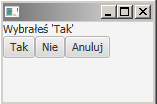FXML tutorial (21) – element Scene w FXML
Listing21_scene.java
package codes; import javafx.application.Application; import javafx.fxml.FXMLLoader; import javafx.scene.Scene; import javafx.stage.Stage; import java.net.URL; import java.util.Objects; public class Listing21_scene extends Application { public static void main(String[] args) { Application.launch(args); } @Override public void start(Stage stage) { try { URL fxmlUrl = this.getClass().getClassLoader().getResource("resources/listing21_scene.fxml"); Scene scene = FXMLLoader.load(Objects.requireNonNull(fxmlUrl)); stage.setScene(scene); stage.show(); } catch (Exception e) { e.printStackTrace(); } } }
listing21_scene.fxml
<?xml version="1.0" encoding="UTF-8"?> <?import javafx.scene.layout.VBox?> <?import javafx.scene.layout.HBox?> <?import javafx.scene.control.Label?> <?import javafx.scene.control.Button?> <?import javafx.scene.Scene ?> <Scene xmlns:fx="http://javafx.com/fxml/1"> <VBox xmlns:fx="http://javafx.com/fxml"> <Label fx:id="lab1" text="Twoja decyzja?"/> <HBox fx:id="hbox"> <Button fx:id="but1" text="Tak"/> <Button fx:id="but2" text="Nie"/> <Button fx:id="but3" text="Anuluj"/> </HBox> </VBox> </Scene>
Po uruchomieniu klasy na ekranie zobaczymy:



